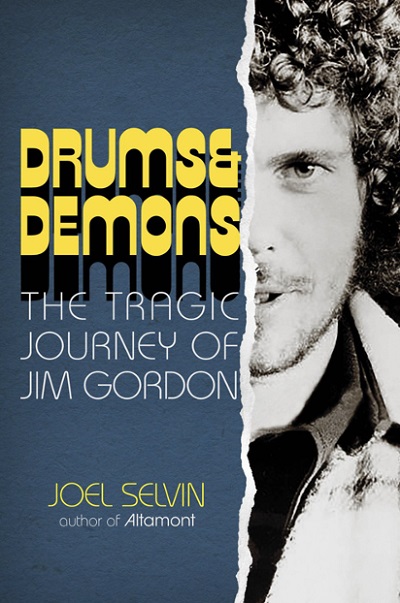The story of drummer Jim Gordon has long been relegated to the back pages of rock and roll history — its arc buttered up with ambition and achievement, gradually shattered by an inner turmoil that lead to madness and murder. In Drums & Demons: The Tragic Journey of Jim Gordon, author Joel Selvin goes deeper into the drummer’s life, filling in any and all gaps in his colorful and extensive career and bitter end. In between recording sessions, Selvin steps inside Gordon’s psyche and speculates a maze filled with internal voices, mainly his mother’s, clouding out his thoughts and struggling with reality. The only calming force in his life was playing the drums, where he excelled.
The list of credits Gordon tallied up in the 20 years that he was active reads like a who’s-who and name-that-tune all-in-one. He started backing the Everly Brothers in 1963, and went on to drum on the Beach Boys’ “Good Vibrations” and “God Only Knows,” Sonny & Cher’s “The Beat Goes On,” Ike & Tina Turner’s “Mountain High – River Deep,” John Lennon’s “Power To The People,” Carly Simon’s “You’re So Vain,” Derek and the Dominos’ “Layla,” which Gordon received a co-writing credit, and dozens if not hundreds more.
Gordon got sucked into the lifestyle as well. He married his high school sweetheart, Jill, and had a daughter, but the perks that come with being a successful musician got the best of him, and he eventually drifted into a number of illicit affairs with several women, including Rita Coolidge and Maria Muldaur. Drugs and alcohol also came into Gordon’s life. Though he didn’t become a crazed addict, substances introduced to his fragile mental state certainly exacerbated the problem.
Whether accurate or by design, Selvin freely inserts Gordon’s mentally challenged episodes into various situations that contributed to his decline. It helps in making Gordon’s life more palpable when the author’s empathetic tone flies in at a low altitude. In many ways, the drummer was complicit in his behavior. He tried to get some help, but pride and ego got the better of him.
Music fans will, of course, marvel at the drummer’s impressive credentials. You may find yourself, as I did, going back and listening to the songs he played on. It’s mind-blowing to think Gordon had accomplished. On the surface, Drums & Demons may play like other rock bios where the protagonist hits a peak before the great fall down to the hole of anonymity. This is a little different. For one, outside of the recording studio, Gordon wasn’t a big name. He was a working musician enjoying the rewards of his success. He wasn’t whacked out of his head, though his general disposition tended to instill others, including Eric Clapton, with an ill-at-ease feeling.
It all ended when he couldn’t control the voices in his head and committed an unforgiveable act. As we find out, winning a Grammy in 1992 for co-writing “Layla” wasn’t going to save him. At time, Gordon had already been prison for nine years. Diagnosed as an acute schizophrenic, he spent the rest of his days behind bars until his passing in 2023.
Selvin’s narrative deftly follows the drummer’s steady rise and heartbreaking fall in all its necessary detail. In the recording industry industry, Jim Gordon’s underlying contributions cannot be denied. Unfortunately, his crime has come to overshadow his legacy. With this book, Selvin presents a broader understanding of the drummer’s perilous plight, so as not to judge him so harshly.
It’s been said, heroes are not defined by their successes, but by how they handle failures. In the case of Drums & Demons: The Tragic Journey of Jim Gordon, the hero simply reached a point of no return from which there was no escape.
~ Shawn Perry




















